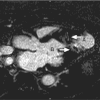Apical hypertrophic cardiomyopathy: preliminary attempt at palliation with use of subselective alcohol ablation
- PMID: 23109786
- PMCID: PMC3461680
Apical hypertrophic cardiomyopathy: preliminary attempt at palliation with use of subselective alcohol ablation
Abstract
We report a case of severe apical hypertrophic cardiomyopathy in order to discuss the nature of this unusual condition and the possibility of using selective alcohol ablation to effectively treat symptomatic hypertrophic cardiomyopathy that presents with apical aneurysm. A 73-year-old woman with severe, progressive dyspnea and intermittent chest pain was found to have localized left ventricular apical dyskinesia distal to an obstructive mid-distal muscular ring. The ring caused total systolic obliteration of the apical left ventricular cavity. Apical cavity pressure was extremely high, up to 330 mmHg-200 mmHg above that in the main left ventricular cavity. Because of the danger of apical rupture and clot formation, we attempted the experimental use of alcohol ablation for effective palliation. We present our pilot experience, offer a novel interpretation of the nature of this obscure entity, and possibly justify a new catheter treatment. In addition, we discuss the developmental, pathophysiologic, and clinical implications of this unusual form of hypertrophic cardiomyopathy. To our knowledge, ours is the first reported use of subselective, modified-protocol alcohol septal ablation to treat an obstructive mid-apical muscular ring in a patient with apical hypertrophic cardiomyopathy.
Keywords: Cardiomyopathy, hypertrophic/complications/epidemiology/physiopathology/therapy; ethanol/administration & dosage/therapeutic use; heart septum/pathology; hypertrophy, left ventricular/diagnosis; myocardial ischemia/complications; treatment outcome.
Figures









Comment in
-
Apical hypertrophic cardiomyopathy.Tex Heart Inst J. 2012;39(5):747-9. Tex Heart Inst J. 2012. PMID: 23109785 Free PMC article. No abstract available.
References
-
- Maron MS, Olivotto I, Zenovich AG, Link MS, Pandian NG, Kuvin JT, et al. Hypertrophic cardiomyopathy is predominantly a disease of left ventricular outflow tract obstruction. Circulation 2006;114(21):2232–9. - PubMed
-
- Maron BJ. Controversies in cardiovascular medicine. Surgical myectomy remains the primary treatment option for severely symptomatic patients with obstructive hypertrophic cardiomyopathy. Circulation 2007;116(2):196–206. - PubMed
-
- Sigwart U. Non-surgical myocardial reduction for hypertrophic obstructive cardiomyopathy. Lancet 1995;346(8969):211–4. - PubMed
-
- Lakkis NM, Nagueh SF, Kleiman NS, Killip D, He ZX, Verani MS, et al. Echocardiography-guided ethanol septal reduction for hypertrophic obstructive cardiomyopathy. Circulation 1998;98(17):1750–5. - PubMed
Publication types
MeSH terms
Substances
LinkOut - more resources
Full Text Sources
Medical
